Review: 2014 Holden Commodore SS-V Redline
#1
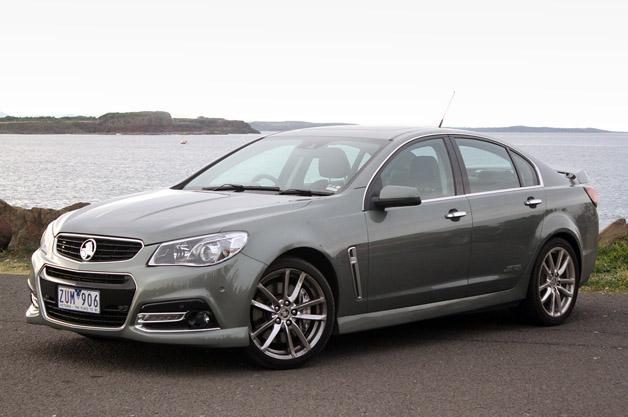
Gallery:
http://www.autoblog.com/photos/2014-...photo-2746432/
Engine: 6.0L V8
Power: 362 HP / 390 LB-FT
Transmission: 6-Speed Manual
0-60 Time: 5.5 Seconds (est.)
Drivetrain: Rear-Wheel Drive
Curb Weight: 3,885 LBS
Seating: 2+3
Base Price: $51,490 AUD
Power: 362 HP / 390 LB-FT
Transmission: 6-Speed Manual
0-60 Time: 5.5 Seconds (est.)
Drivetrain: Rear-Wheel Drive
Curb Weight: 3,885 LBS
Seating: 2+3
Base Price: $51,490 AUD
On a recent jaunt to Australia, we got behind the wheel of a Holden Commodore SS-V Redline. We've been looking forward to driving not a Holden, but the Holden, the Commodore, ever since we visited Australia for the first time in 1994 and saw a Holden Special Vehicles (HSV) Commodore parked like a magazine-spread model in a driveway next to a house on a bluff. It was an indifferent, unavailable and previously unknown exotic.
We pledged the fraternity at the very top, pulling out of the lot at Sutton Holden in Arncliffe in a Commodore SS-V Redline. Easy to confuse for our Chevrolet SS, this is not the Australian export we get. The Holden range comes in eight flavors, the SS-V Redline the uppermost branch on the sports-oriented side of the family tree that employs the LS2 6.0-liter V8 dedicated to Holden's performance models. Our Chevrolet SS is from the HSV tribe, all of its tautly strung warriors using the LS3 6.2-liter V8. The Holden's 6.0-liter puts out 362 horsepower and 390 pound-feet of torque, wheres the SS' 6.2-liter serves up 425 hp and 420 lb-ft.
The SS-V Redline is said to be "the first properly track-developed car to wear a Holden [not an HSV] badge," and ours had a slice of heaven between the front seats: a six-speed manual transmission. According to Aussie journos, the SS-V Redline is "the first Holden that can truly approach HSV offerings," and we couldn't wait to find out what that meant. When we drove straight from the dealer to pick up an Australian friend and she asked, "Is this your big beefy car?" we answered with pride, "Why yes, yes it is."
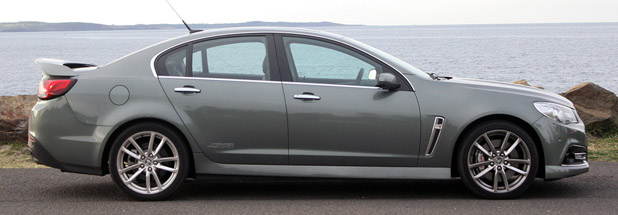
We like the look of the VF-Series Commodore. With so many vintage Commodores on Australia's roads to use as archaeological examples – they're as common as Camrys or Accords in the US – its progression into the current bruising and toothsome evolution of the line is easy to trace, and our eye is generally pleased by the kind of deep-sided, billet-faced presentation that one also finds on sports sedans like the BMW M5 and Jaguar XFR. Even the rear wing works for us, which is not the norm. The only thing that doesn't work to our eyes: all that sparkling, polished trim, including the aforementioned 19-inch wheels. GM global product boss Mark Reuss has called the Chevrolet SS a "four-door Corvette." Well, the Corvette gets by well enough without glitter, and we believe the Commodore SS-V Redline could, too. Nobody thinks the Silverback gorilla is less majestic for not being a Chromeback.
The pageantry continues on the inside, with lustrous bezels gleaming from every quadrant of a pleasant interior. We have to be honest – after coming to this interior from the triple-black-hole of a Hyundai i40 Tourer cabin, anything brighter than a couple of lumens was like staring into the sun. Still, over ten days with the Holden we couldn't stop thinking, "Why so shiny?" Elsewhere, the seats are more comfortable than supportive, the leather around the giant, hard steering wheel feels, at best, like leatherette, the chunky surround for the head-up display is mirrored in the windshield, the faux carbon-fiber-like-patterned trim on the instrument panel and steering wheel is just... no. So why do we call it pleasant? Because it's a cushy place to work and you can tell Holden made an effort, even if it is a touch homespun La-Z-Boy.
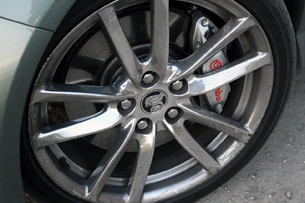
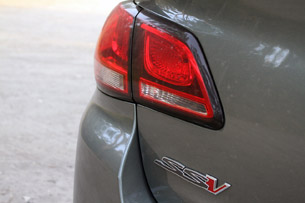
You won't have to worry about what it comes with, though – the leather, head-up display, sunroof, rain-sensing wipers, forward collision alert, lane departure warning, blind spot alert, parking assistance, reverse traffic alert, nav with eight-inch touchscreen are all baked in. The substantive options list runs to exactly three items: metallic paint ($550) and spoiler ($500) and automatic transmission (at $2,200 it was an option our car thankfully eschewed). Our six-speed manual rapture was tempered slightly by a clutch pedal whose travel was too long and whose action was too light. The Competition Mode launch control, activated by pushing the stability control button twice, is also standard fitment. Press the clutch and the accelerator, watch the revs bounce up to 5,000 rpm, dump the clutch and you're off.
With something like 3,885 pounds to pull, you won't be off in a screaming hurry, but it's still plenty brisk; Holden says mid-fives for the 0-62 mile per hour run. We had a terrific time blasting away from lights and revving to the 6,000-rpm redline because of the relative novelty of a manual sedan and the sound – that's what you have to do to get the normally sedate V8 to roar.
The SS-V Redline shades the non-Redline SS-V model below it with the addition of larger Brembo brakes in front, a two-stage traction control with that Comp mode, a unique tune to its FE3 sport suspension with larger anti-roll bars and upgraded dampers and, for the first time ever on a Holden, staggered wheels. Sitting on 19-inch forged alloys all around, this Commodore's back tires are an inch wider than those in front.
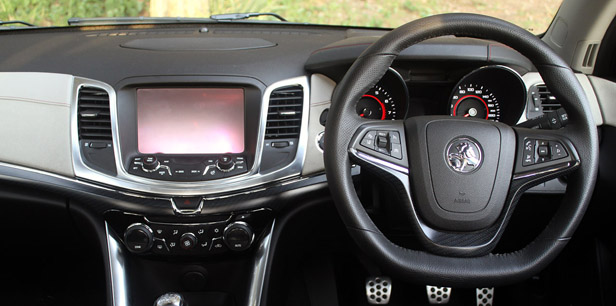
This car isn't about hole shots, it was designed for kerb-to-kerb handling, with the brand's dynamics engineer Rob Trubiani having run a ute version around the Nürburgring in 8:19.47. We didn't have a track, though, only public Aussie roads from Sydney to Ulladulla on the southern coast, and to be honest, we couldn't always understand where the handling hosannas have come from. Not having driven any previous Commodores, we didn't have a performance evolution to give this one credit for, which could make a difference.
Again, coming from the smaller and surprisingly locked-down i40 Tourer, switching to the SS-V Redline felt like going from a cockpit to a control room. The Commodore is big and comfy and a little loosey-goosey, as if all of its nimble bits have to work through that same type of thin, suede-like fuzz that covers some interior panels. The two certifiably precise items are the Brembo brakes and the traction from all that Bridgestone Potenza rubber. Otherwise, we wish the steering was a little more honed – and the wheel quite a bit smaller and the body roll a little less floaty. In short, we wish the whole thing were more nailed down. It's not bad, and on the rolling, curving B-roads that spur off the Princes Highway all along the southern drive, you can get into a nice rhythm. The sedan's tremendous traction is always ready to fulfill the "high-speed" part of "high-speed sweeper," but it will rock a little bit while you do it. Knowing how much the Aussies have helped out with tuning cars for sale here, we were expecting more.
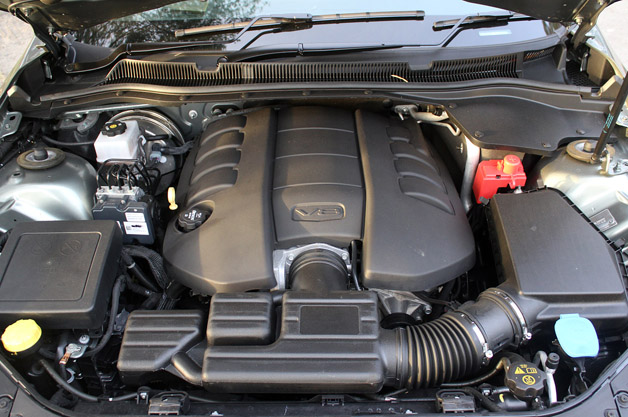
It's a fine old daily commuter, though, with all the mod cons to make your automotive living room sing. Our only knock is on the navigation, which would send us into the Eastern Distributor tunnel underneath Sydney's central business district, then, once in the tunnel, get confused and think we were on surface streets. It would spend our entire time underground trying to get us to turn left or right to find a way into the tunnel we were already in. This happened every single time. And sixth gear is only for fuel economy; the Holden can't pull itself up hills at speed with that last cog.
Your author hadn't driven the Chevrolet SS before the Holden, so the first thing he did upon returning stateside was to book a date with The Bowtie's blistering sedan. Performance-wise, it turns out the SS is the Holden we were looking for, with flat cornering and zero-fuss directional changes accompanying every run up and down various SoCal coastal canyons, and we'd never complain about the SS' extra helping of horsepower and torque. If they'd only put a manual transmission in it...
So the truth is that the fault lies with us – we had the wrong expectations for the SS-V Redline. Those local reviewers who have lauded it as "the first Holden that can truly approach HSV offerings" were right, it's not far off. And it can't get too close, else there'd be no reason to pay the $10,000-AUD premium over the SS-V Redline to take home the least expensive bow in the HSV quiver, the de-contented Clubsport.
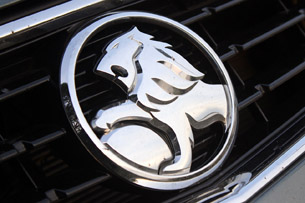
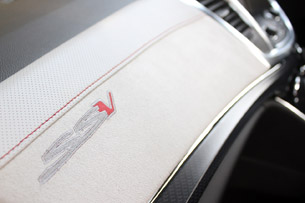
It's time to go back to Reuss' Corvette comment, because the SS-V Redline dares you to find its performance for anywhere near its price. With a retail tag of $51,490 AUD before on-road costs, it's $9,500 less expensive than an HSV Clubsport, has more standard features and is said to be only a couple of tenths away in performance. It's $43,000 less dear than the 577-hp HSV GTS. The Ford Falcon XR6 Turbo with the same horsepower and three more pound-feet from its inline six-cylinder starts at $46,235, but you'll cross the $51K mark after equipping it like the Holden. Plus, there are items you can't get on it like the head-up display, Competition Mode and launch control, and besides, we think the Commodore looks a lot better. Ostensible foreign rivals are even further afield. The local price for a six-cylinder BMW 535i with a lot less horsepower and torque is $103,842 before options, the six-cylinder Mercedes-Benz E400 is $113,842, a Lexus GS 350 F-Sport is $99,000, none of them being twice the car the Holden is, none of them available with a manual transmission. Heck, A Mazda6 Atenza is $46,810, but that's a less-powerful horse of another color... one with an automatic transmission. That's where you find the Holden's most precise attribute of all: where else can you go to find so much for so little? Precisely nowhere.
Which is why we're already shaking our head that the Commodore is going away, and we'll be doing so long after the end of its Australian manufacture in 2017. Yes, when General Motors' Elizabeth, South Australia plant shuts down for good, some kind of sedan from somewhere in the world will be sent to Australia and recent news indicates that it might not be called a Commodore in spite of what the brand's former boss said earlier. Although such opinions inevitably succumb to the waves of progress and drown in the cold, dark depths of history, we think the death of the Commodore name might not be so bad. General Motors wouldn't shut down the Bowling Green, KY assembly plant, import an LS3-engined Opel Cascada and call it a "Corvette."
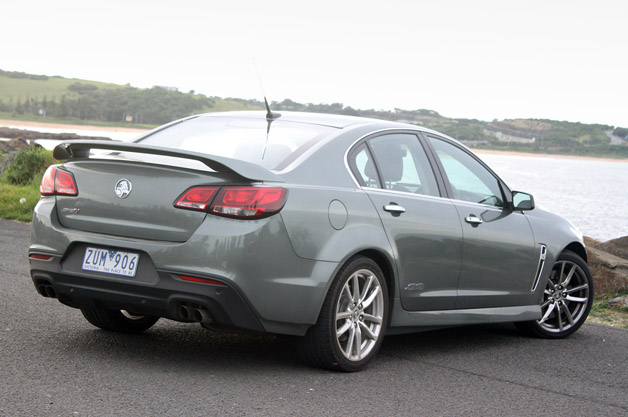
The Commodore is an Australian symbol, not only of its domestic car industry but for many of its people – even for who don't drive it or don't even like it, the same as our Chevrolet Corvette and Ford Mustang. Yet unlike our rather niche icons, the Commodore was the best-selling car in Australia for 15 years, from 1996 to 2010, helping Holden to nearly 30 percent market share around the turn of the millennium. Holden is now languishing in second place with half the market share of Toyota, and the Commodore has been the fourth best-selling car all year behind the Toyota Corolla, Toyota HiLux and Mazda3. It's the only large sedan anywhere near the top of the charts; Falcon numbers are less than one-third of the Commodore's. The Holden Racing Team is the most successful V8 Supercar outfit, the Commodore's rivalry with the Falcon on track and on city streets having led entire family clans to claim one brand or the other – in fact, the Falcon went on sale in Australia in 1960 because Ford desperately needed a locally produced Holden competitor (the Commodore went into production in 1978).
The small size of the Australian market exacerbates the loss. With a land mass about 80 percent the size of the US, its entire population equals that of the New York Metropolitan Area, which comes out to about 7.5 percent of our population. If Nissan had moved 5,000 more vehicles in the US last year, it would have outsold Australia's entire passenger car and commercial vehicle sales total. That's a small pond, and the Holden and Ford exodus means it's about to lose two of its most historically and culturally significant inhabitants. With Toyota announcing that it's ending Australian manufacturing by 2017 – the Japanese company set up shop there in 1959 – the pond has totally dried up.
So, just in case we don't make it down there before the last bell tolls, we're glad we got to drive the SS-V Redline when we did. No matter what its successor is called, there won't be another one like it.
http://www.autoblog.com/2014/07/02/2...edline-review/
#3
It's a shame we don't get the Maloo (Vauxhall) / HSV version of the Commodore here in the U.S. It would, IMO, make a perfect resurrection of the old Chevy El Camino.
Pontiac had plans for a Sport-Truck version of this, but it, of course, died with the division......and Chevy, to date, has not resurrected it.
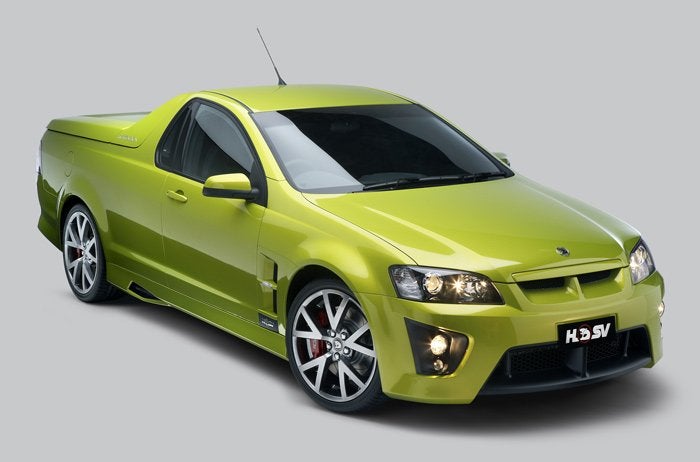
Pontiac had plans for a Sport-Truck version of this, but it, of course, died with the division......and Chevy, to date, has not resurrected it.

#4
The sad thing about these cars is that their future is very uncertain.
The days of sleeper V8 sedans is sadly numbered.
The "next gen" Commodore will most likely be based on a Buick platform sourced from China with a "turbo-4" powerplant.
The irony is that the SS actually does very well here.
The days of sleeper V8 sedans is sadly numbered.
The "next gen" Commodore will most likely be based on a Buick platform sourced from China with a "turbo-4" powerplant.
The irony is that the SS actually does very well here.
#5
Not necessarily next year....but, after that, yes, uncertain.
The problem is that a lot of people don't WANT "sleeper" styling in performance cars. Look what happened, for example, when the Pontiac GTO came out in 2004 (an American version of the Holden Monaro). It was accused of "rental-car" styling, and simply didn't sell, though, in the second year, the addition of the classic GTO twin-hood scoops helped a little.
The days of sleeper V8 sedans is sadly numbered.
#7
Not necessarily next year....but, after that, yes, uncertain.
The problem is that a lot of people don't WANT "sleeper" styling in performance cars. Look what happened, for example, when the Pontiac GTO came out in 2004 (an American version of the Holden Monaro). It was accused of "rental-car" styling, and simply didn't sell, though, in the second year, the addition of the classic GTO twin-hood scoops helped a little.
The problem is that a lot of people don't WANT "sleeper" styling in performance cars. Look what happened, for example, when the Pontiac GTO came out in 2004 (an American version of the Holden Monaro). It was accused of "rental-car" styling, and simply didn't sell, though, in the second year, the addition of the classic GTO twin-hood scoops helped a little.
Trending Topics
#8
#9
I'm personally still more partial to the Falcon. I rented one for a trip to Perth, and rented a Commodore for a Brisbane, Canberra, Sydney and Melbourne trip. Fun big cars. I can only imagine what the performance versions are like.
#10
I was only pointing out, though, that many other people, though, do take sleek styling into account, and that was one reason why the Holden-based GTO and G8 didn't sell better than they did.
#11
This should make alternatives a bit cheaper. Maybe not Holden / HSV levels cheap, but considerably less so.
Thread
Thread Starter
Forum
Replies
Last Post



